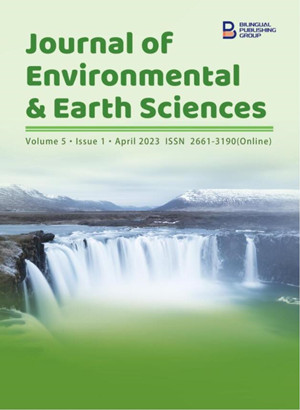
Quantum Atmospheric Biophysics: A Comparison of Four Weather Stations in India on Average Monthly Temperatures Since 1892 and Forecasts to 2150
DOI:
https://doi.org/10.30564/jees.v5i1.4942Abstract
The identification method revealed asymmetric wavelets of dynamics, as fractal quanta of the behavior of the surface air layer at a height of 2 m, according to the average monthly temperature at four weather stations in India (Srinagar, Jolhpur, New Delhi and Guvahati). For Srinagar station, the maximum for all years is observed in July, for Jolhpur and New Delhi stations it shifts to June, and for Guvahati it shifts to August. With a high correlation coefficient of 0.9659, 0.8640 and 0.8687, a three-factor model of the form was obtained. The altitude, longitude and latitude of the station are given sequentially. The hottest month for Srinagar over a period of 130 years is in July. At the same time, the temperature increased from 23.4 °C to 24.2 °C (by 3.31%). A noticeable decrease in the intensity of heat flows in June occurred at Jolhpur (over 125 years, a decrease from 36.2 °C to 33.3 °C, or by 8.71%) and New Delhi (over 90 years, a decrease from 35.1 °C to 32.4 °C, or by 7.69%). For almost 120 years, Guvahati has experienced complex climate changes: In 1902, the hottest month was July, but in 2021 it has shifted to August. The increase in temperature at various stations is considered. At Srinagar station in 2021, compared to 1892, temperatures increased in June, September and October. Guvahati has a 120-year increase in December, January, March and April. Temperatures have risen in February, March and April at Jolhpur in 125 years, but have risen in February and March at New Delhi Station in 90 years. Despite the presence of tropical evergreen forests, the area around Guvahati Station is expected to experience strong warming.
Keywords:
India; 4 weather stations; Average monthly temperature; Waves of behavior; Sum of wavelets; Verification; ForecastsReferences
[1] Ancient India [Internet] [cited 2022 Apr 22]. Available from: https://history.wikireading.ru/314323
[2] Kumar, B., Asad, A.I., Chandraaroy, B., et al., 2019. Perception and knowledge on climate change: A case study of university students in Bangladesh. Journal of Atmospheric Science Research. 2(3), 17-22.DOI: https://doi.org/10.30564/jasr.v2i3.1542
[3] India Getting Warmer, Hotter: 2021 Fifth Warmest Year Since 1901, Says IMD [Internet] [cited 2022 Apr 22]. Available from: https://www.business-standard.com/article/current-affairs/india-getting-warmer-hotter-2021-fifth-warmest-year-since-1901-says-imd-122011401133_1.html
[4] Climate of India [Internet] [cited 2022 Apr 22]. Available from: https://fb.ru/article/146454/klimat-indii-osobennosti-klimata-indii
[5] Kumar, P., Pinjarla, B., Joshi, P.K., et al., 2021. Long term spatio-temporal variations of seasonal and decadal aridity in India. Journal of Atmospheric Science Research. 4(3), 29-45.DOI: https://doi.org/10.30564/jasr.v4i3.3475
[6] Gopalakrishna, T., Lomax, G., Aguirre-Gutiérrez, J., et al., 2022. Existing land uses constrain climate change mitigation potential of forest restoration in India. Conservation Letters. e12867. DOI: https://doi.org/10.1111/conl.12867
[7] Mazurkin, P.M., 2022. Asymmetric mean annual temperature wavelets surface air layer of Berlin for 1701-2021. Journal of Atmospheric Science Research. 5(3), 1-9. DOI: https://doi.org/10.30564/jasr.v5i3.4674
[8] Mazurkin, P.M., 2022. Quantum Biophysics of the atmosphere: Asymmetric wavelets of the average annual air temperature of Irkutsk for 1820-2019. Journal of Environmental & Earth Sciences. 4(2), 1-16.DOI: https://doi.org/10.30564/jees.v4i2.4586
[9] Mazurkin, P.M., 2022. Wave dynamics of the average annual temperature surface air layer New Delhi for 1931-2021. Journal of Atmospheric Science Research. 5(2), 52-66.DOI: https://doi.org/10.30564/jasr.v5i2.4639
[10] Mazurkin, P.M., 2021. Bioclimatic regularities of change in the density of organic carbon of the steppe soil in different regions of the World. Journal of Atmospheric Science Research. 4(1), 16-25. DOI: https://doi.org/10.30564/jasr.v4i1.2521
[11] Mazurkin, P.M., 2021. Factor analysis of the parameters of samples of the steppe soil and grass of Mongolia and Inland Mongolia of China on the eastern transect of the Eurasian steppe. Journal of Geological Research. 3(1), 1-10. DOI: https://doi.org/10.30564/jgr.v3i1.2520
[12] Dahlhausen, J., Rötzer, T., Biber, P., et al., 2018. Urban climate modifies tree growth in Berlin. International Journal of Biometeorology. 62, 795-808. DOI: https://doi.org/10.1007/s00484-017-1481-3
[13] Roya, P.S., Behera, M.D., Murthyc, M.S.R., et al., 2015. New vegetation type map of India prepared using satellite remote sensing: Comparison with global vegetation maps and utilities. International Journal of Applied Earth Observation and Geoinformation. 39, 142-159. DOI: http://dx.doi.org/10.1016/j.jag.2015.03.003
Downloads
How to Cite
Issue
Article Type
License
Copyright © 2023 Author(s)

This is an open access article under the Creative Commons Attribution-NonCommercial 4.0 International (CC BY-NC 4.0) License.







 Mazurkin Peter Matveevich
Mazurkin Peter Matveevich






